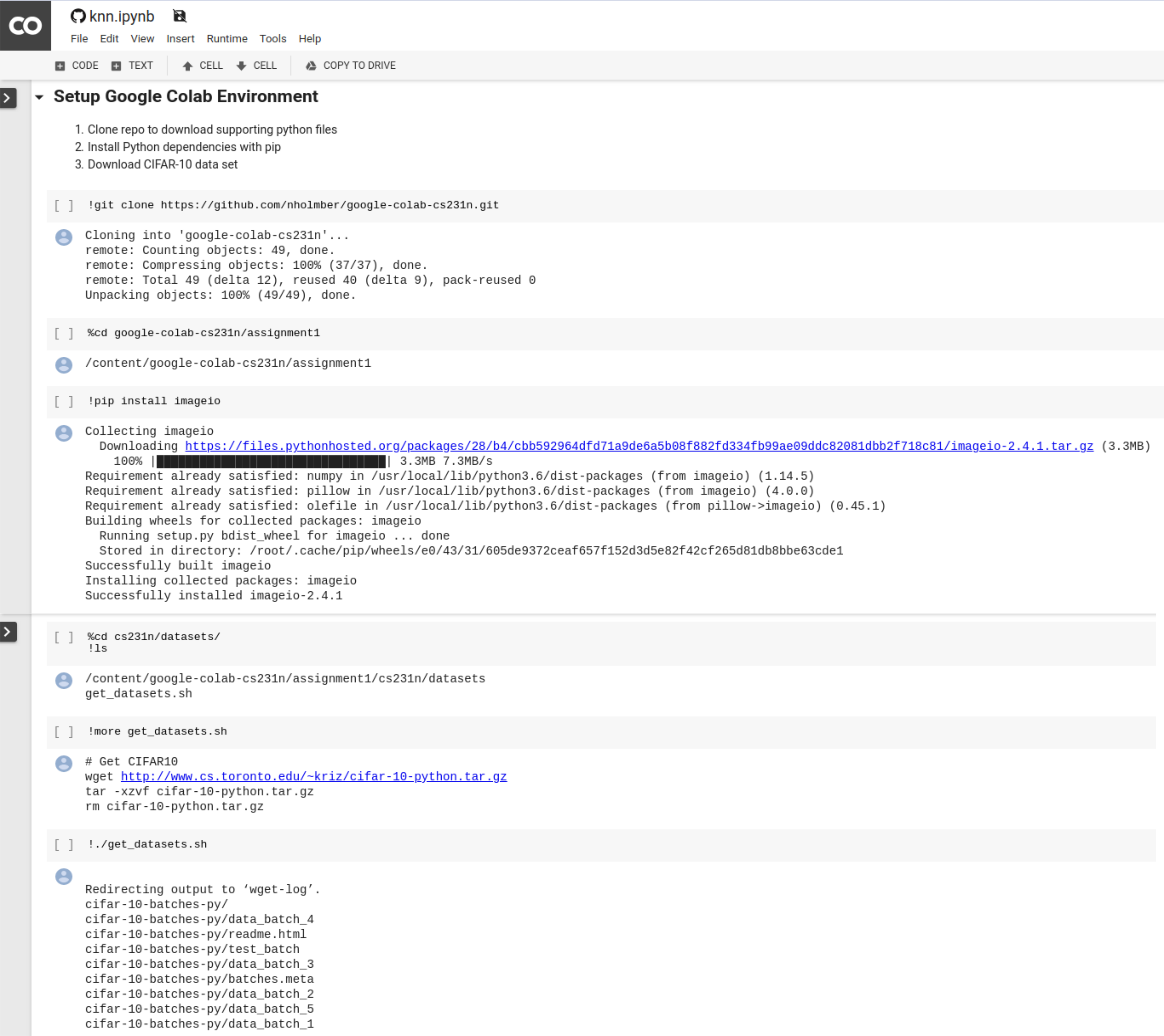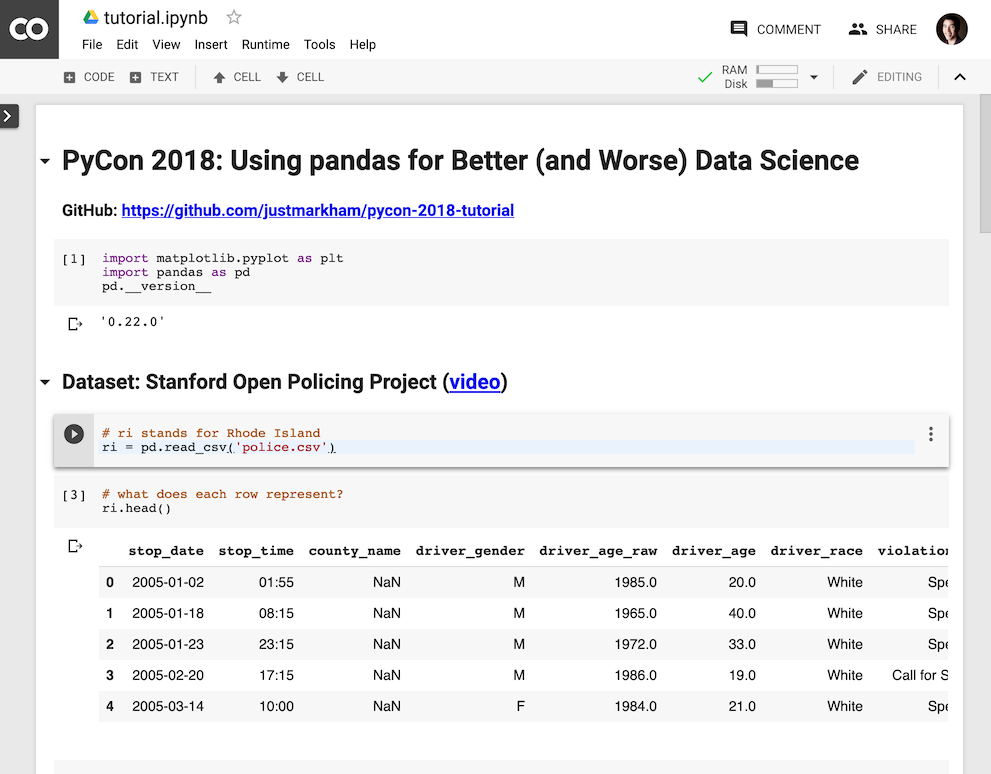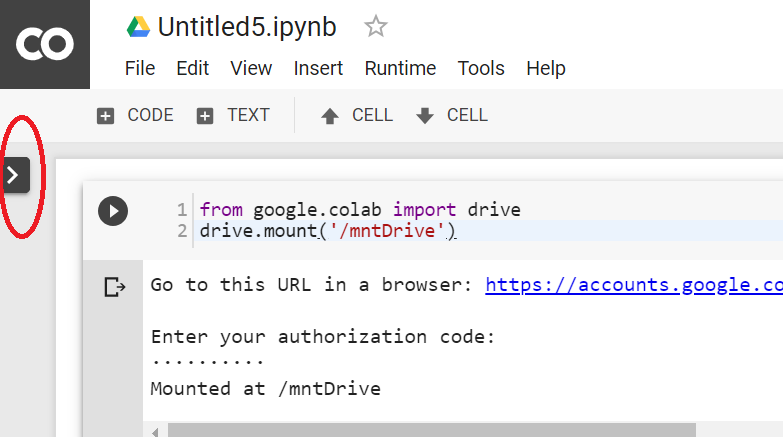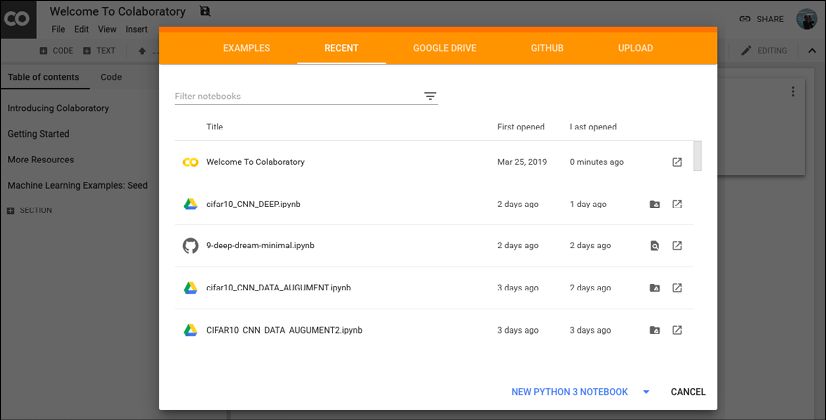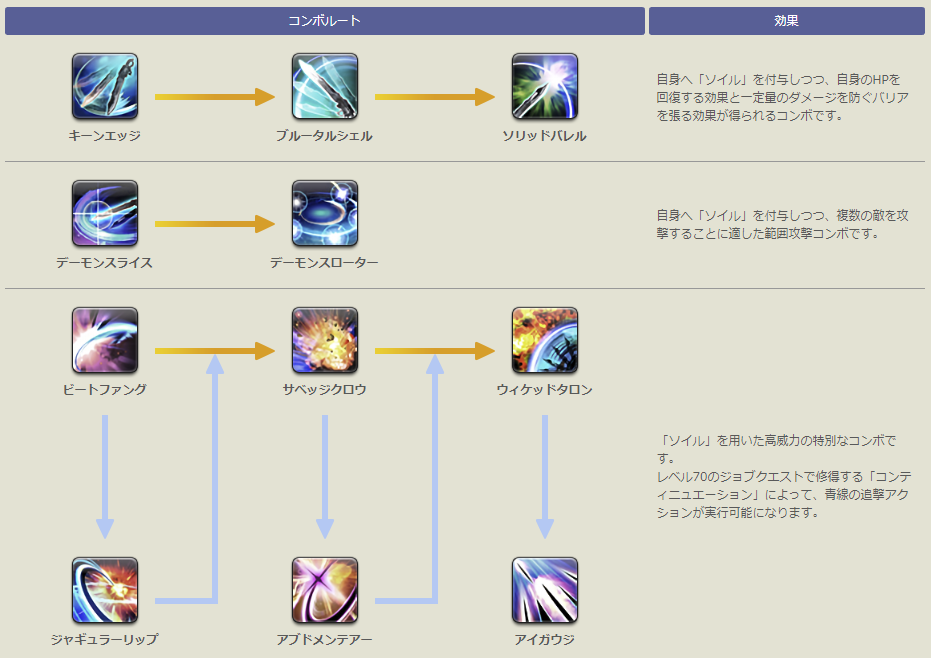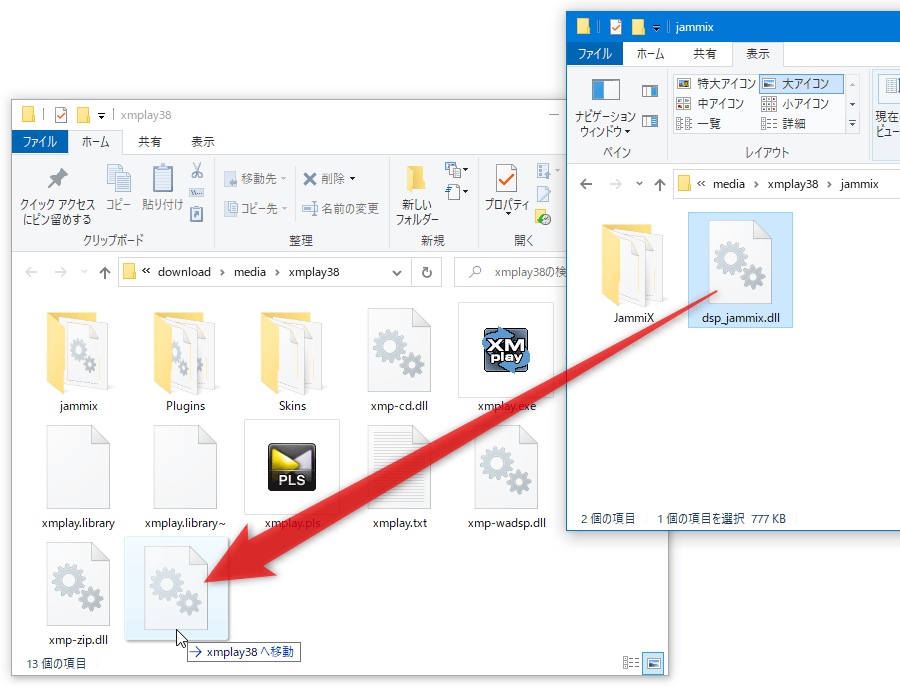Google colab - How to Use Google Colab for Deep Learning
Python Installation
Below, the markdown cell, add a code cell with the snippet code. Click on a new notebook to create a new runtime instance. Instead, you are supposed to use Markdown for your Headings. Image objects can be displayed to notebook output cells. TensorBoard in Google Colab TensorBoard is a toolkit provided by Tensorflow for visualizing data related to machine learning. To get the most out of Colab, consider closing your Colab tabs when you are done with your work, and avoid opting for a GPU when it is not needed for your work. Additionally, if you are having an interest in learning Data Science, click to start Furthermore, if you want to read more about data science, you can read our blogs. The code will be inserted into a new cell. The more pound signs you use, the smaller the header. Machine learning has never been easier! How can I get the most out of Colab? This can be helpful in cases where a virtual machine has become unhealthy e. No dedicated hardware or software installation needed. Jupyter Notebook even kind of previews it for you: Then when you run the cell, you will end up with a nicely formatted header: Creating Lists You can create a list bullet points by using dashes, plus signs, or asterisks. Import the API Run the following cell to import the API into your session. Setup Conda environment If you use miniconda as your python environment manager, you can setup it on colab by running these commands at the top of your notebook. This rule of thumb works for the majority of common use-cases. After a cell is executed, just hover over the cell run icon and you will get an estimate of the execution time taken. Send feedback Python Installation - Colab Notebook The Earth Engine Python API can be deployed in a Google Colaboratory notebook. To mitigate this issue, Google Colab offers us not only the classic CPU runtime but also an option for a GPU and TPU runtime as well. Notebooks run by connecting to virtual machines that have maximum lifetimes that can be as much as 12 hours. What types of GPUs are available in Colab? Adjusting memory over time allows us to continue to offer Colab for free. To add, in Jupyter notebooks, we can either be in insert mode or escape mode. Paste that key in the provided space to verify your account. This content is also available as a Colab notebook: The Earth Engine API is included by default in Google Colaboratory so requires only importing and authenticating. The model is very basic, it categorizes images as numbers and recognizes them. This is necessary for Colab to be able to provide access to these resources for free. First, you need to install flask and flask-ngrok. Training a model with Keras Keras is an API written in Python, it runs on top of Tensorflow. Note that using Colab for cryptocurrency mining is disallowed entirely, and may result in your account being restricted for use with Colab altogether. It will open a new notebook with R set as the kernel instead of Python. System Aliases Jupyter includes shortcuts for common operations, such as ls and others. For example, here we view the class definition of the Dense layer in Keras by pressing Ctrl and then clicking the Dense class name. To upload and download files on GCP, first you need to authenticate your Google account. The amount of memory available in Colab virtual machines varies over time but is stable for the lifetime of the VM. Colab limits how often this can be done to prevent undue resource consumption. To use it, run the following code. This is where I put things I find useful that speed up my work with Machine Learning. The GPUs available in Colab often include Nvidia K80s, T4s, P4s and P100s. Existing notebook Existing notebook files. Missing functionality Currently, the release process to GitHub and PyPi is done manually, it's prone to errors, and the two scripts used work best in happy-path use-case scenarios while edge-case even though less to worry about are not taken care of, as well as they could have been. Hardware Google Colab recently added support for Tensor Processing Unit TPU apart from its existing GPU and CPU instances. Follow the instructions printed to the cell to complete this step. In order to be able to offer computational resources for free, Colab needs to maintain the flexibility to adjust usage limits and hardware availability on the fly. These notebooks find the usage in cases where you need story telling with your code! You can configure what font family is used for monospace in most modern browsers. In escape mode, we can add cells with b, delete a cell with x, and undo deletion of a cell with z. You also have the option to opt-out of these cookies. GOOGLE DRIVE: Jupyter notebook in your google drive. Get hold of all the important Machine Learning Concepts with the at a student-friendly price and become industry ready. Colab provides an inbuilt feature to do this. Current memory and storage usage Colab provides an indicator of RAM and disk usage. Note that before using the API you must initialize it. This makes sure that you can run cells afterward in the notebook without your background task blocking it. Before diving directly into writing code, let us familiarise ourselves with writing the code notebook style! Ever looked in your old projects to reuse those cool functions you created before? Run VSCode on Colab You can run a full-fledged VSCode editor on Colab by following the method I have explained in another. Google Drive Colab notebooks can exist in various folders in depending on where notebooks files were created. Just click the icon on sidebar, search for your snippet name and click Insert. Import API and get credentials This section demonstrates how to import the Earth Engine Python API and authenticate access. Visiting the Colab interface after initial use will result in a file explorer modal appearing. Saving and loading weights of a model The basic aim of training a DL model is to adjust the weights in such a way that it predicts the output correctly. Colab files can be identified by a yellow 'CO' symbol and '. But I found a mental model to map between them. You can then copy that command and execute it in your Colab notebook to download the dataset. What are the usage limits of Colab? In that regard, they offer a number of advantages over any local scripts or tools. More technically, Colab is a hosted Jupyter notebook service that requires no setup to use, while providing free access to computing resources including GPUs. Interactive Tables for Pandas Colab provides a notebook extension to add interactive sorting and filtering capabilities to pandas dataframes. Just accept it and colab will notify you on task completion even if you are on another tab, window or application. After that, install gsutil to upload and download files, and then init gcloud. If you are interested in doing more in Colab than the resource limits of the free version of Colab allow, please try out Colab Pro and let us know what you think. The release to PyPi should be fail-safe as there is no way to revert if a mistake is made. There are 2 ways to mount a Drive in Colab: Using code snippet Execute this code block to mount your Google Drive on Colab: from google. Colab uses HTML iframes and service workers hosted on separate origins in order to display rich outputs securely. For examples of how to utilize GPU and TPU runtimes in Colab, see the and example notebooks. From the tabs at the top of the file explorer, select a source and navigate to the. The cookies is used to store the user consent for the cookies in the category "Necessary". Go to Training more complex and larger models To train complex models, you often need to load large datasets. Jupyter Notebook is maintained by the people at. It seems that Google Colab GPU's doesn't come with CUDA Toolkit, how can I install CUDA in Google Colab GPU's. To add each of your snippets, create a markdown cell and add name of the snippet as header. List as a client-side Python list. Well, this repo is designed to be a Python Library of functions I created in my previous project that can be reused. As a result, users who use Colab for long-running computations, or users who have recently used more resources in Colab, are more likely to run into usage limits and have their access to GPUs and TPUs temporarily restricted. If you encounter this problem, try moving files and folders directly contained in "My Drive" into sub-folders. It does not store any personal data. Introduction Interactive notebooks are experiencing a rise in popularity. Our long term goal is to continue providing a free version of Colab, while also growing in a sustainable fashion to meet the needs of our users. Live real-time avatars from your webcam in the browser. Pricing Despite being so good at hardware, the services provided by Google Colab are completely free. A similar problem can occur when reading from other folders after a successful drive. You can learn to use it from the. Hence a safe practice is to move the dataset into your cloud drive as soon as the dataset is downloaded completely. Resources in Colab are prioritized for users who have recently used less resources, in order to prevent the monopolization of limited resources by a small number of users. For inline code highlighting, just surround the code with backticks. Just add Ctrl + M before whatever keyboard shortcut you were using in Jupyter. It also manages the notebook in your Google Drive, providing a stable and organized data management system for programmers who want to work on the same project together. Downloading the dataset from GCP or Google Drive Google Cloud Platform is a cloud computing and storage platform. Note that "deleting" files or subfolders by moving them to the Trash may not be enough; if that doesn't seem to help, make sure to also. This is overwhelmingly helpful for startups, the research community and students in deep learning space Working with Notebooks — The Cells Based Method Jupyter Notebook supports adding rich content to its cells. The Raw NBConvert cell type is only intended for special use cases when using the nbconvert command line tool. In some cases, you might need less popular libraries, or you might need to run code on a different version of a library. Switch between Tensorflow versions You can easily switch between Tensorflow 1 and Tensorflow 2 using this magic flag. To execute the cell, press shift + enter. The types of GPUs that are available in Colab vary over time. Jupyter ships with the IPython kernel, which allows you to write your programs in Python, but there are currently over 100 other kernels that you can also use. Executing code in a GPU or TPU runtime does not automatically mean that the GPU or TPU is being utilized. Training a sample tensorflow model Training a machine learning model in Colab is very easy. Set a new cell to Markdown and then add the following text to the cell: When you run the cell, the output should look like this: If you would prefer to bold your text, use a double underscore or double asterisk. Cell Types There are technically four cell types: Code, Markdown, Raw NBConvert, and Heading. The variable declared in one cell can be used in other cells as a global variable. Colab interface Visit the and create a new file. These steps must be completed for each new Colab session or if you restart your Colab kernel or if your Colab virtual machine is recycled due to inactivity. The Notebook way Traditionally, notebooks have been used to document research and make results reproducible, simply by rerunning the notebook on source data. If an attempt fails, please try again later. The following two examples demonstrate displaying a static image and an interactive map. Mounting a drive Google Colab allows you to import data from your Google Drive account so that you can access training data from Google Drive, and use large datasets for training. It will redirect you to a colab notebook. You can also use the default storage available in Colab, and download the dataset directly to Colab from GCS or Kaggle. If you are unfamiliar with Google Colab or Jupyter notebooks, please spend some time exploring the. Initialize Fetch a Landsat image. Run R programs in Google Colab You can use R programming language in Google Colab by going to. Luckily, Neptune AI lets you manage your machine learning experiments in a natural, robust fashion. This will import all the data from your Drive to the runtime instance. There is no way to choose what type of GPU you can connect to in Colab at any given time. Colab recommends using the pre-installed Tensorflow version instead of installing it from pip for performance reasons. If you want to insert a block of code, you can use triple backticks and also specify the programming language: Useful Jupyter Notebook Extensions Extensions are a very productive way of enhancing your productivity on Jupyter Notebooks. Boon for Research and Startup Community Perhaps this is the only tool available in the market which provides such a good PaaS for free to users. In this blog, we are going to learn about Jupyter notebooks and Google colab. Gauge resource limits Colab provides the following specs for their free and pro versions. Out of these, the cookies that are categorized as necessary are stored on your browser as they are essential for the working of basic functionalities of the website. But opting out of some of these cookies may affect your browsing experience. Open Notebooks from GitHub The Google Colab team provides an official chrome extension to open notebooks on GitHub directly on colab. These cookies will be stored in your browser only with your consent. The GPU runtime shows better flexibility and programmability for irregular computations, such as small batches and nonMatMul computations. While the interface is very easy to use, there are many lesser-known and undocumented features in colab. In this lesson, we learned about Jupyter notebooks. But why would one want to choose to use a notebook instead of a favorite IDE or command line? To install a particular version of TensorFlow use this command:! For example, to download a file from some. Basically, it allows you to control the formatting in a very specific way when converting from a Notebook to another format. You just need to set the logs directory location using the --logdir flag. There are many limitations in the current browser-based notebook implementations, but what they do offer is an environment for exploration, collaboration, and visualization. Print the elevation of Mount Everest. Notebooks will also disconnect from VMs when left idle for too long. Google Drive imposes a limit on how much data can be stored in it by each user. Why do Drive operations sometimes fail due to storage quota? Press enter to mount the Drive. Deep learning datasets can be massive in size, ranging between 20 to 50 Gb. Google Drive operations can time out when the number of files or subfolders in a folder grows too large. We can also change the type of a cell to markdown with m and to Python code with y. The CPU runtime is best for training large models because of the high memory it provides. This is necessary for Colab to be able to offer computational resources for free. Jupyter Notebooks The Jupyter Notebook is an open source web application that you can use to create and share documents that contain live code, equations, visualizations, and text. The following script provides an example of adding a method for handing Earth Engine tiles and using it to display an elevation model to a Leaflet map. An alternative to enabling third-party cookies for all sites is to allow the following hostname in your browser settings: googleusercontent. RECENT: Jupyter notebook you have recently worked with. For more details, see Users who are interested in more reliable access to better resources may be interested in. With its free GPU, and the ability to import data from Google Drive, Colab stands out as a very effective platform for training models on low-end machines with computational and storage limitations. Now you can directly download from there, Or, you can just open file hierarchy and right clicking will give download option. If you choose to share a notebook, the full contents of your notebook text, code, output, and comments will be shared. Initialize You'll be asked to authorize access to your Earth Engine account. This guide demonstrates setup and testing with a new Colab notebook, but the process applies to shared and saved notebooks as well. Manage Colab Notebooks from Command Line You can use a library called to easily create and sync colab notebooks with your local notebooks. GPUs and TPUs are sometimes prioritized for users who use Colab interactively rather than for long-running computations, or for users who have recently used less resources in Colab. Tensorboard Integration Colab also provides a magic command to use Tensorboard directly from the notebook. The most efficient way to use datasets is to use a cloud interface to download them, rather than manually uploading the dataset from a local machine. Why prompt to enable third-party cookies? Trigger the authentication flow. To solve this, you can bookmark the link given below. You just have to use the humble pound sign. The exclamation point tells the notebook cell to run the following command as a shell command. Even if you have a GPU or a good computer creating a local environment with anaconda and installing packages and resolving installation issues are a hassle. If lots of people start using jupyter notebooks, then we could look into whether JupyterHub would be of benefit. Run Flask apps from Colab With a library called , you can easily expose a Flask web app running on colab to demo prototypes. Initialize Import a DEM and display a thumbnail of it. Colab offers optional accelerated compute environments, including GPU and TPU. The TPU runtime is highly-optimized for large batches and CNNs and has the highest training throughput. Integration with Drive Colaboratory is integrated with Google Drive. In this section, you will get an overview of just some of the things you can do with your cells using Markup and Code. NOTE : By default, the Colab notebook uses Python shell. These cookies ensure basic functionalities and security features of the website, anonymously. This is necessary for Colab to be able to provide resources for free. Action Jupyter Notebook Google Colab Add a cell above A Ctrl + M + A Add a cell below B Ctrl + M + B See all keyboard shorcuts H Ctrl + M + H Change cell to code Y Ctrl + M + Y Change cell to markdown M Ctrl + M + M Interrupt the kernel II Ctrl + M + I Delete a cell DD Ctrl + M + D Checkpoint notebook Ctrl + S Ctrl + M + S Below are some notable exceptions to this rule for which either the shortcut is changed completely or kept the same. You could also copy the cell and re-run the copy only if you want to retain a record of the previous attempt. To avoid hitting your GPU , we recommend switching to a standard runtime if you are not utilizing the GPU. And other Colabs providing an accessible interface for using FOMM, Wav2Lip and Liquid-warping-GAN with your own media and a rich GUI. A pure Google Colab wrapper for live First-order-motion-model, aka Avatarify in the browser. With Colaboratory you can write and execute code, save and share your analyses, and access powerful computing resources, all for free from your browser. The environment automatically prints the value of the variable in the last line of the code block if stated explicitly. Jupyter Notebooks are a spin-off project from the IPython project, which used to have an IPython Notebook project itself. Notebooks also tend to be set up in a cluster environment, allowing the data scientist to take advantage of computational resources beyond what is available on her laptop, and operate on the full data set without having to download a local copy. To save weights manually, use: model. Google Colab is a great platform for deep learning enthusiasts, and it can also be used to test basic machine learning models, gain experience, and develop an intuition about deep learning aspects such as hyperparameter tuning, preprocessing data, model complexity, overfitting and more. This will make it less likely that you will run into usage limits in Colab. Colab resources are not guaranteed and not unlimited, and the usage limits sometimes fluctuate. Send feedback Except as otherwise noted, the content of this page is licensed under the , and code samples are licensed under the. If thousands of items are directly contained in the top-level "My Drive" folder then mounting the drive will likely time out. Colaboratory is a free Jupyter notebook environment provided by Google where you can use free GPUs and TPUs which can solve all these issues. Though, you can refer the details in. GITHUB: You can add Jupyter notebook from your GitHub but you first need to connect Colab with GitHub. UPLOAD: Upload from your local directory. Folium has no default method for handling tiles from Earth Engine, so one must be defined and added to the folium. This tutorial will cover some of the basics of what you can do with Markdown. Note: Installing the Earth Engine API and authenticating are necessary steps each time you begin working with a Colab notebook. Training it every time would be very frustrating and time-consuming. It will open a special scratch notebook and any changes you make to that notebook are not saved to your main account. You can save the entire model and export it to other machines. If you are not a registered Earth Engine user, please. Google Colab supports both GPU and TPU instances, which makes it a perfect tool for deep learning and data analytics enthusiasts because of computational limitations on local machines. New notebook Google Drive Open and create a new file. The name, Jupyter, comes from the core supported programming languages that it supports: Julia, Python, and R. The data is loaded from the standard Keras dataset archive. While in insert mode, we can edit the cells and undo changes within that cell with cmd + z on a mac or ctl + z on windows. Thankfully, Colab gives us a variety of ways to download the dataset from common data hosting platforms. Add a code cell, enter the following lines, and run the cell. Moreover, the notebooks are saved to your Google Drive account. Else you can create a new Jupyter notebook by clicking New Python3 Notebook or New Python2 Notebook at the bottom right corner. There are a collection of awesome extensions you can use for your projects. Note that purchasing more space on Drive will not increase the amount of disk available on Colab VMs. Monitoring data using TensorBoard To use TensorBoard, you need to import some necessary libraries. Headers Creating headers in Markdown is also quite simple. Repeated attempts may eventually succeed as failed attempts cache partial state locally before timing out. In fact, Neptune allows you to streamline and. Colab is able to provide free resources in part by having dynamic usage limits that sometimes fluctuate, and by not providing guaranteed or unlimited resources. However, I have not investigated this in detail as there is no need for it yet.。
All About Using Jupyter Notebooks and Google Colab
。
python
。
。
All About Using Jupyter Notebooks and Google Colab
。
Colaboratory
。
- 関連記事
2021 www.proinnovate.co.uk



